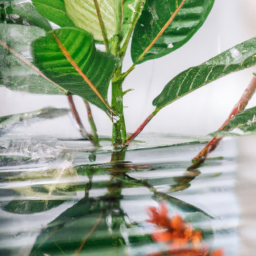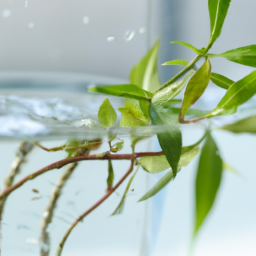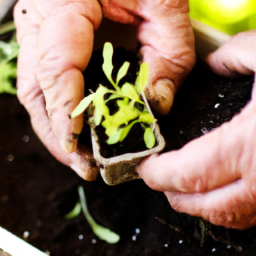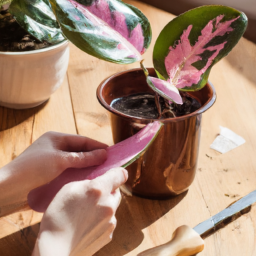
Have you ever wondered how to propagate Croton plants in water? Croton propagation in water is a popular method for multiplying these vibrant and colorful plants. Whether you’re a seasoned gardener looking to expand your collection or a beginner wanting to try your hand at plant propagation, this method is simple and effective. In this blog post, we will walk you through the steps of propagating Croton plants in water, from selecting the right cuttings to caring for them as they root and grow. So grab your clippers and a glass of water, and let’s get started on propagating your own beautiful Croton plants!
Benefits of Croton Propagation in Water
Introduction
As an expert in plant propagation, I can confidently say that propagating Croton plants in water has numerous benefits. Croton plants, known for their vibrant and colorful foliage, can easily be propagated in water, making it a popular method among plant enthusiasts. In this guide, I will walk you through the step-by-step process of propagating Croton plants in water and highlight the benefits of this propagation method.
Benefits of Water Propagation
1. Easy and Cost-effective
One of the main benefits of propagating Croton plants in water is that it is a simple and cost-effective method. All you need is a glass of water and a healthy cutting from a mature Croton plant. This method eliminates the need for potting soil and reduces the risk of transplant shock, making it ideal for beginners and experienced gardeners alike.
Additionally, water propagation allows you to monitor the root development of the cutting closely, ensuring that it is healthy and ready for transplanting into soil. This method is also a great way to propagate multiple plants at once, as you can place several cuttings in a single container of water.
Overall, water propagation is a convenient and budget-friendly way to expand your Croton plant collection and create new plants from existing ones.
2. Faster Root Development
Compared to traditional soil propagation methods, propagating Croton plants in water can result in faster root development. The cuttings placed in water are able to absorb nutrients and moisture more efficiently, leading to quicker root growth. This means that you can expect to see roots forming on your Croton cuttings in a matter of weeks, rather than months.
Faster root development not only speeds up the propagation process but also increases the chances of success. Strong and healthy roots are essential for the overall health and growth of the plant, making water propagation an attractive option for those looking to propagate Croton plants quickly and effectively.
By providing the cuttings with the right conditions, such as adequate sunlight and regular water changes, you can ensure optimal root development and successful propagation of your Croton plants.
3. Healthier Plants
Another benefit of propagating Croton plants in water is that it can lead to healthier plants in the long run. Water propagation allows you to closely monitor the root development of the cuttings, making it easier to detect any issues or diseases early on. By keeping a close eye on the roots, you can ensure that they are healthy and free from any problems before transplanting the cuttings into soil.
Healthy roots are crucial for the overall health and vitality of the plant, as they are responsible for absorbing nutrients and water from the soil. By starting the propagation process in water, you can give your Croton plants a strong foundation for growth and development, resulting in healthier and more resilient plants in the future.
By taking the time to propagate your Croton plants in water and ensuring that the roots are healthy and well-established, you can set them up for success and enjoy beautiful, vibrant foliage for years to come.

Step-by-Step Guide to Propagating Croton in Water
Are you looking to expand your collection of beautiful Croton plants? Propagating Croton in water is a simple and rewarding way to grow new plants from cuttings. In this guide, I will walk you through the step-by-step process of propagating Croton in water, so you can enjoy the vibrant colors and unique foliage of this stunning plant in your own home.
Preparing the Cuttings
Before you can start propagating Croton in water, you will need to gather some healthy cuttings from a mature Croton plant. Choose a stem that is at least 4-6 inches long and has several leaves on it. Use a sharp, clean pair of scissors or pruning shears to make a clean cut just below a leaf node. This is where the roots will eventually grow from.
Remove any leaves from the bottom 2 inches of the cutting, as these will be submerged in water and could rot. You can also dip the cut end of the stem in rooting hormone powder to encourage root growth, although this is optional. Once you have prepared your cuttings, it’s time to move on to the next step.
Fill a clean glass or jar with room temperature water, making sure that the water level is high enough to cover the bottom 2 inches of the cuttings. Place the cuttings in the water, making sure that the leaves are not submerged. You can place multiple cuttings in the same container, as long as they are not overcrowded.
Caring for the Cuttings
Place the container of cuttings in a warm, bright location, but out of direct sunlight. Change the water every few days to prevent it from becoming stagnant and to provide fresh nutrients to the cuttings. You may also want to add a few drops of liquid fertilizer to the water to help promote root growth.
Monitor the cuttings regularly for signs of root growth, which can take anywhere from a few weeks to a few months. Once the cuttings have developed a healthy root system, you can transplant them into potting soil to continue growing into mature Croton plants. Make sure to keep the soil consistently moist and provide plenty of sunlight to encourage growth.
Remember to be patient and consistent in caring for your propagating Croton cuttings. With time and proper care, you will soon have a beautiful collection of vibrant Croton plants to brighten up your home.
Troubleshooting Common Issues
If you notice that your cuttings are not developing roots or are starting to wilt, there may be a few common issues to address. Make sure that the water is clean and free of any contaminants, as this can prevent root growth. Additionally, check that the cuttings are not receiving too much or too little sunlight, as this can also affect their growth.
If your cuttings are struggling to develop roots, you can try adding a rooting hormone to the water or transferring them to a different container with fresh water. Be patient and continue to monitor and care for your cuttings, and they should eventually start to thrive.
By following these steps and tips, you can successfully propagate Croton in water and enjoy the beauty of this stunning plant in your own home. Happy propagating!

Common Mistakes to Avoid When Propagating Croton in Water
Not Using the Right Tools
One of the most common mistakes people make when propagating Croton in water is not using the right tools. It is important to use clean, sharp scissors or pruning shears to cut the stem of the plant. Using dull or dirty tools can introduce bacteria or fungi to the plant, which can hinder its growth.
Additionally, make sure to use a clean container with fresh water for propagating the Croton. Using dirty or contaminated water can also lead to problems with the plant’s growth. It is best to use filtered or distilled water to avoid any issues.
Lastly, using the right rooting hormone can help speed up the propagation process. Make sure to use a hormone that is specifically designed for woody plants like Croton to ensure successful propagation.
Overwatering or Underwatering
Another common mistake when propagating Croton in water is overwatering or underwatering the plant. It is important to find the right balance when it comes to watering the plant. Croton plants prefer to be kept slightly moist but not waterlogged.
Check the water level in the container regularly and top up as needed to ensure the plant’s roots are always submerged in water. However, be careful not to let the water level get too high, as this can lead to root rot. On the other hand, if the water level gets too low, the plant may not be able to take up enough water to survive.
It is best to check the plant daily and adjust the water level as needed to avoid overwatering or underwatering the Croton during the propagation process.
Not Providing Enough Light
One of the key factors in successfully propagating Croton in water is providing enough light for the plant to grow. Croton plants require bright, indirect light to thrive. Placing the container near a sunny window or under a grow light can help ensure the plant gets enough light to grow.
A common mistake people make is placing the container in a dark or shaded area, which can slow down the plant’s growth or even cause it to die. Make sure to provide at least 6-8 hours of bright, indirect light per day for the best results when propagating Croton in water.
By avoiding these common mistakes and following the proper steps for propagating Croton in water, you can successfully grow new plants from cuttings and enjoy a beautiful and thriving garden.
Here’s what we learned
If you’re looking to expand your indoor plant collection without breaking the bank, propagating your croton plant in water is a simple and cost-effective way to do so. Crotons are known for their vibrant and colorful foliage, making them a popular choice for adding a pop of color to any room. By following a few easy steps, you can easily propagate your croton plant in water and watch it grow into a beautiful new plant.
To propagate your croton plant in water, start by taking a cutting from a healthy, mature plant. Make sure the cutting has at least two nodes, which are the points where leaves grow. Place the cutting in a glass of water, making sure that at least one node is submerged. Change the water every few days to prevent bacteria buildup and watch as roots begin to grow from the submerged node. Once the roots are a few inches long, you can transfer the cutting to a pot with soil and continue to care for it as you would a mature croton plant. With a little patience and care, you’ll soon have a new croton plant to brighten up your home.
FAQ Roundup:
Q1. Can I propagate Croton plants in water?
A1. Yes, Croton plants can be propagated in water. It is a simple and effective method to propagate new plants from cuttings.
Q2. How do I propagate Croton plants in water?
A2. To propagate Croton plants in water, simply take a cutting from a healthy, established plant and place it in a container of water. Make sure to change the water regularly to prevent stagnation.
Q3. How long does it take for Croton cuttings to root in water?
A3. Croton cuttings typically root in water within 2-4 weeks. Keep an eye on the cutting for signs of root development, such as white roots emerging from the stem.
Q4. Can I plant Croton cuttings directly in soil after rooting in water?
A4. Yes, once the Croton cuttings have developed roots in water, they can be planted directly in soil. Make sure to provide the new plants with proper care and watering to help them establish in their new environment.
Q5. Are there any tips for successful Croton propagation in water?
A5. To increase the chances of successful Croton propagation in water, make sure to use a clean container with fresh water, place the cutting in a bright, indirect light location, and monitor the progress regularly. Keep the water level consistent and change it every few days to prevent bacterial growth.
Dr. Olivia Green is a botanist with over two decades of experience in indoor plant cultivation. She holds a Ph.D. in Plant Biology and has dedicated her career to researching plant behavior in controlled environments. Dr. Green is passionate about helping plant enthusiasts master the art of indoor gardening through her extensive knowledge and practical insights.


